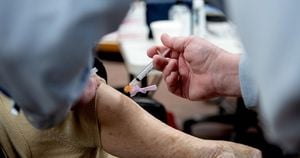Tesla is taking strides forward with its humanoid robot project, known as Optimus, and it's making waves with its unique employment strategy. The company is currently hiring Data Collection Operators to don motion-capture suits, with pay reaching up to $48 per hour, to collect data for training its robots.
The job listings are popping up on platforms like LinkedIn and Indeed, emphasizing the need for candidates willing to walk for seven hours daily, all wrapped up in high-tech gear. Applicants must fit specific height requirements, ideally standing between 5'7" and 5'11", closely matching the projected height of the Optimus robot, noted to be around 5'8".
Workers will wear virtual reality headsets and motion-capture suits to simulate the movements intended for the robots as they gather movement data to refine the AI's performance. The need for this extensive data collection stems from the ambition to automate tasks traditionally performed by human workers.
This innovative method mirrors how Tesla trains its Autopilot system, using real-world data to improve functionality. The Data Collection Operators will not only gather data but will also analyze it and prepare reports, adding another layer to their responsibilities.
Christian Hubicki, a roboticist at Florida A&M University, points out the correlation between the sizes of the operators and the robots. This attention to detail helps optimize how the robots might replicate human movements effectively.
Elon Musk initially unveiled the Optimus project back in 2021, stating it would help with dangerous, tedious, or repetitive tasks. This initiative has gained significance, especially as companies increasingly turn to automation amid burgeoning labor shortages.
Videos shared across Tesla’s platforms showcase workers expertly mimicking actionable tasks like lifting and placing objects, showcasing the interplay between human actions and robot responses. Observably, the robots are already performing tasks independently, nudging closer toward their practical applications.
Despite the excitement surrounding the Optimus project, the review of Tesla's progress has not been entirely smooth. Early prototypes received lukewarm responses from experts after their debut, illustrating high expectations surrounding Tesla's capabilities.
Contemplation around the project's feasibility raises concerns about scaling the robots for production. Animesh Garg, from Nvidia Research, estimates the data collection expenses could soar near half-a-billion dollars, with uncertainty surrounding the ultimate success of such endeavors.
Elon Musk's vision for Optimus includes generating over 20 billion units worldwide, stirring speculation about transforming industries and even households. This ambitious outlook emphasizes Musk's confidence, with hopes to leverage robots to propel Tesla’s valuation to market highs.
The competition, though, is heating up; other companies like Figure—backed by tech giants like Microsoft and Nvidia—are racing to develop similar robots for practical applications, particularly within sectors like automotive manufacturing. This highlights the growing race to refine artificial intelligence and robotics on large scales, with Tesla confronting considerable competition.
Therefore, there's considerable pressure on Tesla to deliver efficiently. The execution of perfectly functioning, humanoid robots prepared to work side-by-side with humans is no easy task, fostering skepticism among observers and experts alike.
To truly make Optimus support factory operations, substantial investment and increased research continuity are imperative. Current indicators suggest the company is on the right path, but the road is fraught with challenges, and the stakes are high.
The process has sparked curiosity and drawn attention to how human labor can shape the future of robotics. Observers are watching closely, wondering if Tesla can convert the vast amounts of data gathered through these innovative training techniques.
The notion of integrating humanoid robots within Tesla's ecosystem reflects broader trends across industries aimed at increasing automation capabilities. With the rapid evolution of AI technologies, each development seems poised to reshape traditional working environments.
Elon Musk's vision, optimistic as it can be, brings to light the need for real-world applications where robots can operate effectively. Current efforts surrounding the Optimus project epitomize Tesla's determination to reassert itself as a frontrunner not just among automobile makers but as leaders in AI-driven automation.
The breadth of tasks Optimus is expected to conquer showcases the scaling potential robots hold, paving the way toward significant cost savings and efficiency increases for companies who adopt them. The ambitious project prompts many questions about the future of labor as tasks shift from human hands to advanced algorithms.
Whether Tesla can maintain momentum will be key to its standing against other players vying for market share. Observers remain skeptical yet intrigued about how quickly and effectively Optimus can be brought to fruition, illustrating the intersection of hope, investment, and innovation at play.
With the recruitment of Data Collection Operators, there’s potential for broader community engagement as more individuals become involved with the advancing technology. While the hiring spree provides new job opportunities, how sustainable these roles are remains to be seen.
Corporate challenges accompany ambitious goals, but if anyone can make it work, it’s likely this collective vision spearheaded by Tesla. The engaging thought of having humanoid robots fulfilling roles across various industries keeps public interest alive and sets the stage for future developments.
Tesla's commitment to maintaining its edge places it at the forefront of tech changes reshaping industries. Whether the world will see the widespread integration of robots like Optimus depends on how the ambitious project evolves moving forward.
Public curiosity surrounds the future as Tesla navigates through competition and potential obstacles. With data collection efforts ramping up, all eyes will be on how those efforts translate to successful robotic productivity on the factory floor and beyond.



